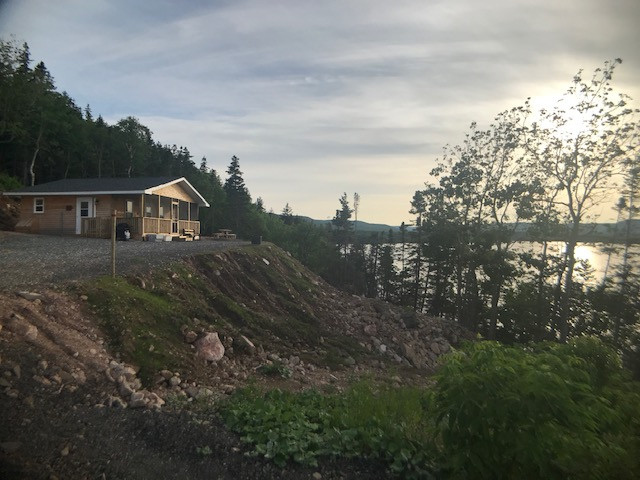Cabot Trail Summer Vacation Cottage
The Cabot Trail
300KM (185Miles) of jaw dropping scenery
Little Brook Cottage a perfect base to enjoy it all from.
The Cabot Trail
Little Brook Cottage
We are located at the top of the Cabot Trail, ideally positioned to be your base for touring the trail, over 26 hiking trails within 1 hour of the cottage.
The Cabot Trail, a scenic roadway that takes you around the greater part of Nova Scotia Cape Breton, is one of the most famous drives in Canada. Many visitors to Cape Breton set aside an entire day – or two, three or four days – to see the sights along the Cabot Trail. Because there are so many scenic overlooks, cultural heritage sites, whale watching hiking trails and guided tours on the Cabot Trail, spending some time planning your excursion and accommodations will make your road trip much more enjoyable.
Choose a Direction
The Cabot Trail makes a loop around Cape Breton Island, cutting across the top of the island and closely following the western and eastern coastlines. If you travel in a clockwise direction, you'll be on the "inside" lane as you drive along both coasts. Because the road goes up and down steep grades and curves, the clockwise direction is better for drivers (and passengers) who dislike driving next to steep drops. Many of the turnoffs into Cape Breton Highlands National Park are right turns if you are traveling clockwise.
Driving counter-clockwise may give you a better view of some of the more spectacular ocean vistas along the way. While this direction is less popular (it's billed as the direction for the brave driver), it may be easier to handle if you dislike slow traffic, as fewer people travel counter-clockwise.
How long to drive the trail
It is about an 8 hour trip around the trail, so why not split the journey in 2, stay at the Little Brook Cottage which is half way point and enjoy all that the Cabot Trail and the Highlands national park has to offer at a more leisurely pace.
Cycling is about a 6 day trip. Give yourself enough time to see the park and enjoy the hills and scenery.
History of the Cabot Trail, Cape Breton, Nova Scotia.
The history of the Cabot Trail begins with the Micmacs, who were the first inhabitants of the region
.The name Micmac means "my kin-friends", these Natives lived throughout Cape Breton Island in small groups prior to being placed on reserves. In the year 1497 the first Europeans, led by the famed explorer John Cabot arrived on Cape Breton. Cabot's discovery of the island led to it's eventual settlement by Europeans, mainly by the Scots, Irish, French and English. This mixture of cultures remains on the the island to this day. Many of these European settlers came to the region in an attempt to escape persecution in their homelands. During the Acadian Expulsion, a number of the French escaped to Prince Edward Island and the Magdalene Islands. They later crossed over and settled on what is now the Cabot Trail. Many of the English who settled around the Cabot Trail, arrived as refugees after the American Revolution, when being a loyalist meant confiscation of lands, social ostracism and possible death. Thousands fled in the years after the revolution, many of whom were given land grants from the British government as a reward for their loyalty

The mid 1700's brought major changes to the Highlands of Scotland with the end of the Highland Clan System, increased population and a dim future. Many sought a better place to live and new opportunities. For these reasons many Scot's left their homelands and made new homes in Cape Breton. Cape Breton has since become a stronghold of Gaelic culture, some say more fiercely Scottish than Scotland. In the final years of the 18th Century, early census show many Irish living in Cape Breton. In fact, in smaller numbers, they arrived before the Scot's, coming from Ireland via Newfoundland. Irish Surnames are still found in many communities around the Cabot Trail. At first the settlers who came to Cape Breton hugged the coast-line for two reasons: they were a seafaring people and the fact that Cape Breton was an "untamed, savage country" with difficult terrain. Fishing and coastal trade dominated the culture and economy of the island into the early tweentieth century. Over time as the land was cleared, Cape Breton started to develop an agricultural base, farms began to not only be able to support themselves, but to trade their products by sea. This resulted in a more stable environment and schools and churches began to be built. But because the soil was so easily depleted, a lot of the farm land was reclaimed by the forest
The population of Cape Breton has declined since the 1880's, due to the changing economic and social patterns that lure many to the United States and metropolitan Canada, in the search of employment. Ironically, others have settled in Cape Breton seeking refuge from the city life. It wasn't until the early 1930's one could travel by car over the Cape Breton Highlands. Cheticamp on the western side, while the foot of Cape Smokey on the eastern side would be the end of your travel. The sea would then become your way of travel. The communities in the highlands were extremely isolated, supplies could only be brought in by boat and the mail would be delivered by horse back or dog team in the winter. Life in these settlements was one of hardship, however the Scottish and Irish pioneers were of a strong breed, and determined to live as highlanders of Cape Breton.

The beauty of this solitude was not invisible by the provincial government, as they saw potential for tourism in Cape Breton. With little need of encouragement, the road from Cape North to Cheticamp was underway in 1926. By the fall of 1927 a route from Cheticamp to Pleasant Bay was accomplished. A 24 mile section over some of the most rugged terrain in North America. Beyond Pleasant Bay to Cape North there remained only a foot path. Not until 1932 did Reverend R.L. MacDonald become the first person to drive the Cabot Trail. Over 10 hours to travel , from Cheticamp to Cape North, approximately 50 miles.
Little brook Cottage
Summer cottage rental - Cabot Trail - Cape Breton
About the cottages
Cottages # 1 & #3
- Sleeps max 4
- Bed Linen supplied
- Towels supplied
- Shower
- Bathroom
- Heating and A/C
- Kitchen
- Stove
- Fridge
- Cutlery
- Cooking basics
- microwave
- coffee maker
- Kettle
- WiFi
- Parking
- Water access
Check in time: 3pm
Check out time: 11am
Driving time
we are 2 hours from Sydney
5 hours from Halifax
- No Smoking
- No Pets
- Fire extinguisher
- smoke/Carbon monoxide detector
- Fire Pit
- BBQ
Accommodations Cottage # 1 & #3
Bedrooms
- 2 x bedrooms
- Bedroom 1
- 1 x Double size bed
- Bedroom 2
- Twin size bunk beds
- Living Room
- Bathroom with full size shower.
- Open plan living room kitchen,dinning area.
- Deck overlooking harbour.
Do you have any questions?
© Copyright www.littlebrookcottage.ca

